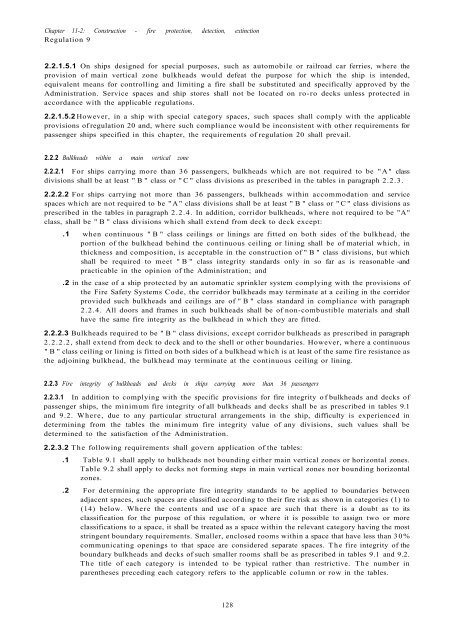Solas Consolidated Edition 2009.pdf
Solas Consolidated Edition 2009 for maritime
Solas Consolidated Edition 2009 for maritime
You also want an ePaper? Increase the reach of your titles
YUMPU automatically turns print PDFs into web optimized ePapers that Google loves.
Chapter 11-2: Construction - fire protection, detection, extinction<br />
Regulation 9<br />
2.2.1.5.1 On ships designed for special purposes, such as automobile or railroad car ferries, where the<br />
provision of main vertical zone bulkheads would defeat the purpose for which the ship is intended,<br />
equivalent means for controlling and limiting a fire shall be substituted and specifically approved by the<br />
Administration. Service spaces and ship stores shall not be located on ro-ro decks unless protected in<br />
accordance with the applicable regulations.<br />
2.2.1.5.2 However, in a ship with special category spaces, such spaces shall comply with the applicable<br />
provisions of regulation 20 and, where such compliance would be inconsistent with other requirements for<br />
passenger ships specified in this chapter, the requirements of regulation 20 shall prevail.<br />
2.2.2 Bulkheads within a main vertical zone<br />
2.2.2.1 For ships carrying more than 36 passengers, bulkheads which are not required to be "A" class<br />
divisions shall be at least "B" class or "C" class divisions as prescribed in the tables in paragraph 2.2.3.<br />
2.2.2.2 For ships carrying not more than 36 passengers, bulkheads within accommodation and service<br />
spaces which are not required to be "A" class divisions shall be at least "B" class or "C" class divisions as<br />
prescribed in the tables in paragraph 2.2.4. In addition, corridor bulkheads, where not required to be "A"<br />
class, shall be "B" class divisions which shall extend from deck to deck except:<br />
.1 when continuous "B" class ceilings or linings are fitted on both sides of the bulkhead, the<br />
portion of the bulkhead behind the continuous ceiling or lining shall be of material which, in<br />
thickness and composition, is acceptable in the construction of "B" class divisions, but which<br />
shall be required to meet "B" class integrity standards only in so far as is reasonable -and<br />
practicable in the opinion of the Administration; and<br />
.2 in the case of a ship protected by an automatic sprinkler system complying with the provisions of<br />
the Fire Safety Systems Code, the corridor bulkheads may terminate at a ceiling in the corridor<br />
provided such bulkheads and ceilings are of "B" class standard in compliance with paragraph<br />
2.2.4. All doors and frames in such bulkheads shall be of non-combustible materials and shall<br />
have the same fire integrity as the bulkhead in which they are fitted.<br />
2.2.2.3 Bulkheads required to be "B" class divisions, except corridor bulkheads as prescribed in paragraph<br />
2.2.2.2, shall extend from deck to deck and to the shell or other boundaries. However, where a continuous<br />
"B" class ceiling or lining is fitted on both sides of a bulkhead which is at least of the same fire resistance as<br />
the adjoining bulkhead, the bulkhead may terminate at the continuous ceiling or lining.<br />
2.2.3 Fire integrity of bulkheads and decks in ships carrying more than 36 passengers<br />
2.2.3.1 In addition to complying with the specific provisions for fire integrity of bulkheads and decks of<br />
passenger ships, the minimum fire integrity of all bulkheads and decks shall be as prescribed in tables 9.1<br />
and 9.2. Where, due to any particular structural arrangements in the ship, difficulty is experienced in<br />
determining from the tables the minimum fire integrity value of any divisions, such values shall be<br />
determined to the satisfaction of the Administration.<br />
2.2.3.2 The following requirements shall govern application of the tables:<br />
.1 Table 9.1 shall apply to bulkheads not bounding either main vertical zones or horizontal zones.<br />
Table 9.2 shall apply to decks not forming steps in main vertical zones nor bounding horizontal<br />
zones.<br />
.2 For determining the appropriate fire integrity standards to be applied to boundaries between<br />
adjacent spaces, such spaces are classified according to their fire risk as shown in categories (1) to<br />
(14) below. Where the contents and use of a space are such that there is a doubt as to its<br />
classification for the purpose of this regulation, or where it is possible to assign two or more<br />
classifications to a space, it shall be treated as a space within the relevant category having the most<br />
stringent boundary requirements. Smaller, enclosed rooms within a space that have less than 30%<br />
communicating openings to that space are considered separate spaces. The fire integrity of the<br />
boundary bulkheads and decks of such smaller rooms shall be as prescribed in tables 9.1 and 9.2.<br />
The title of each category is intended to be typical rather than restrictive. The number in<br />
parentheses preceding each category refers to the applicable column or row in the tables.<br />
128


